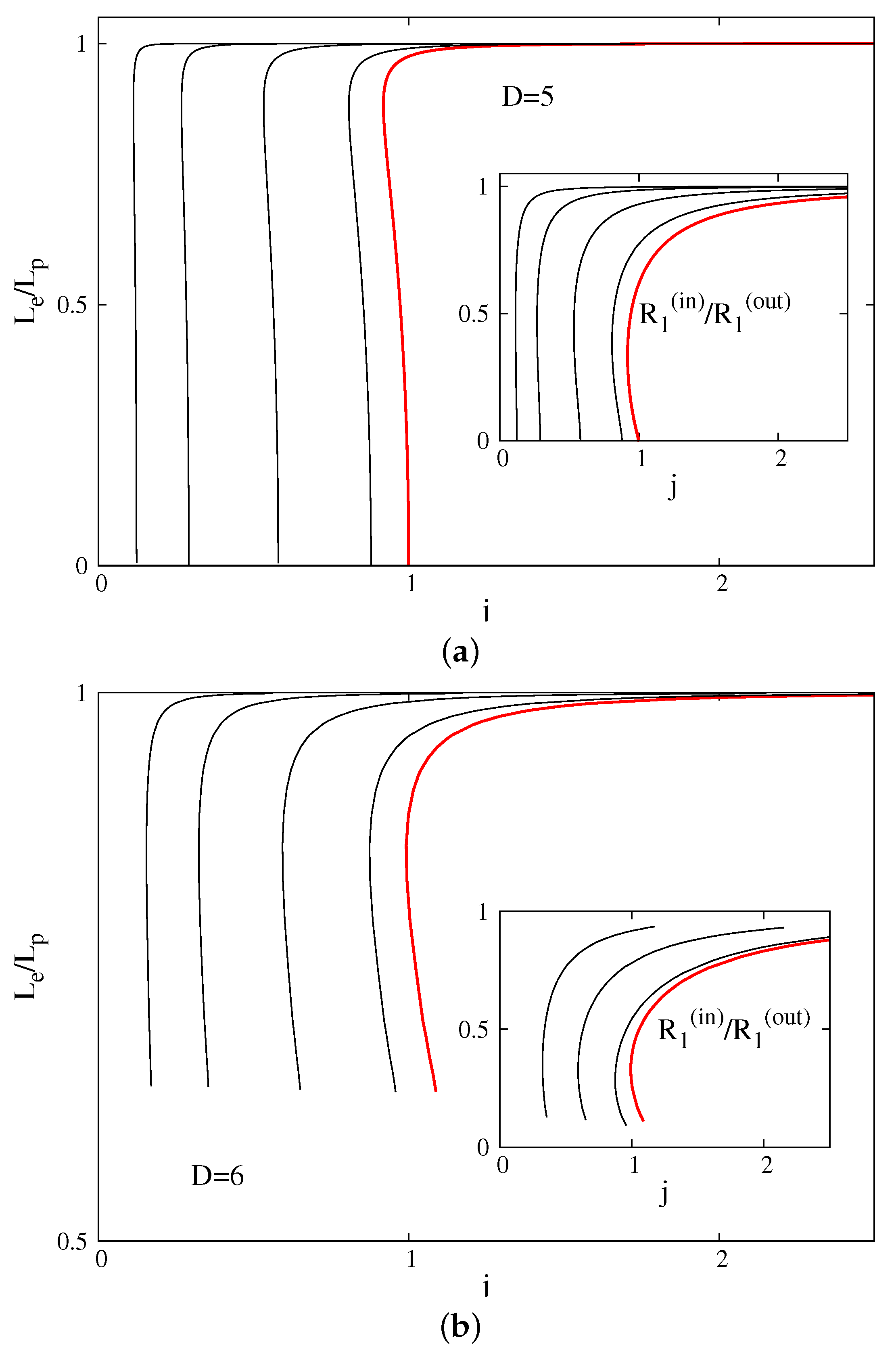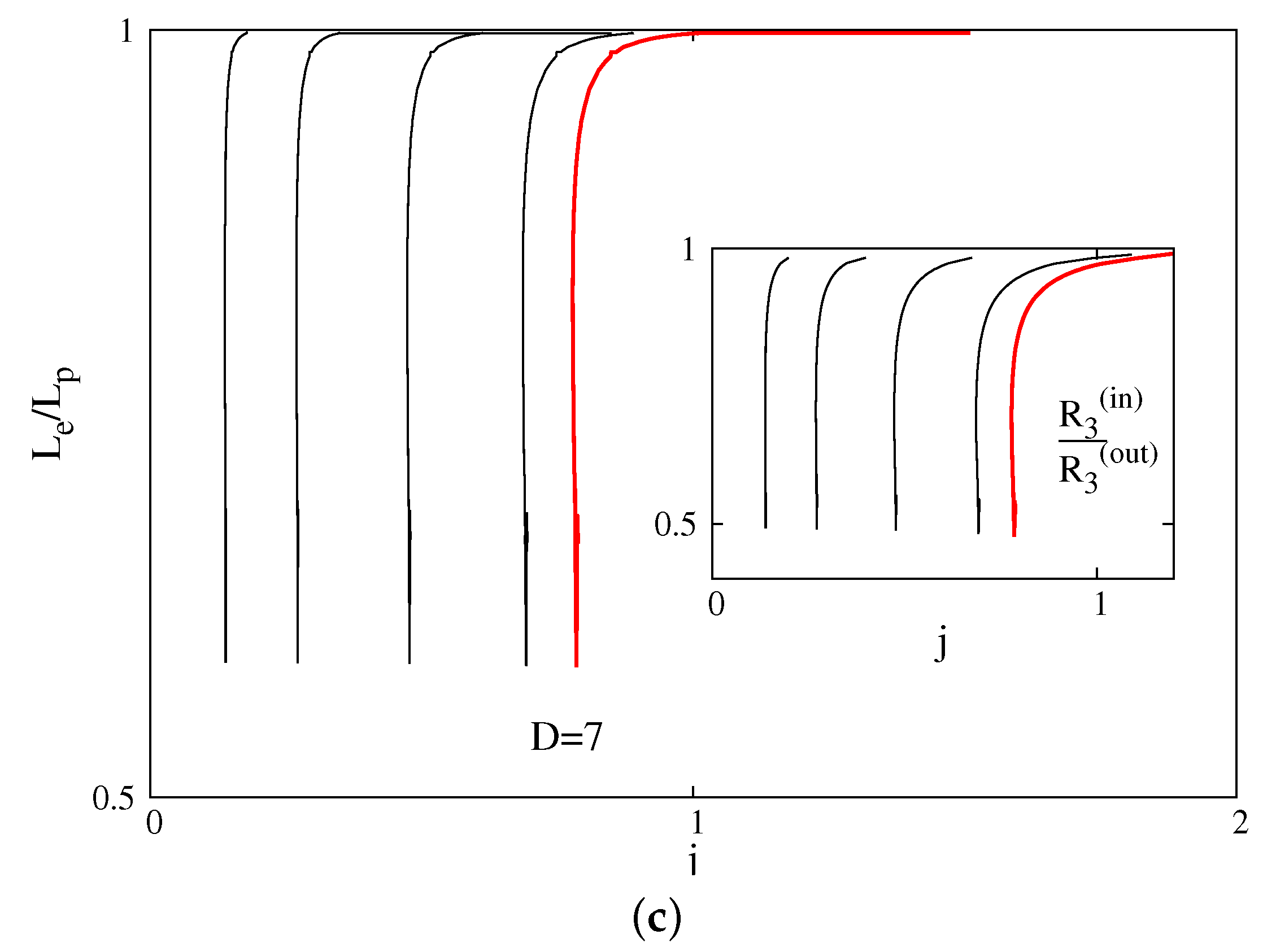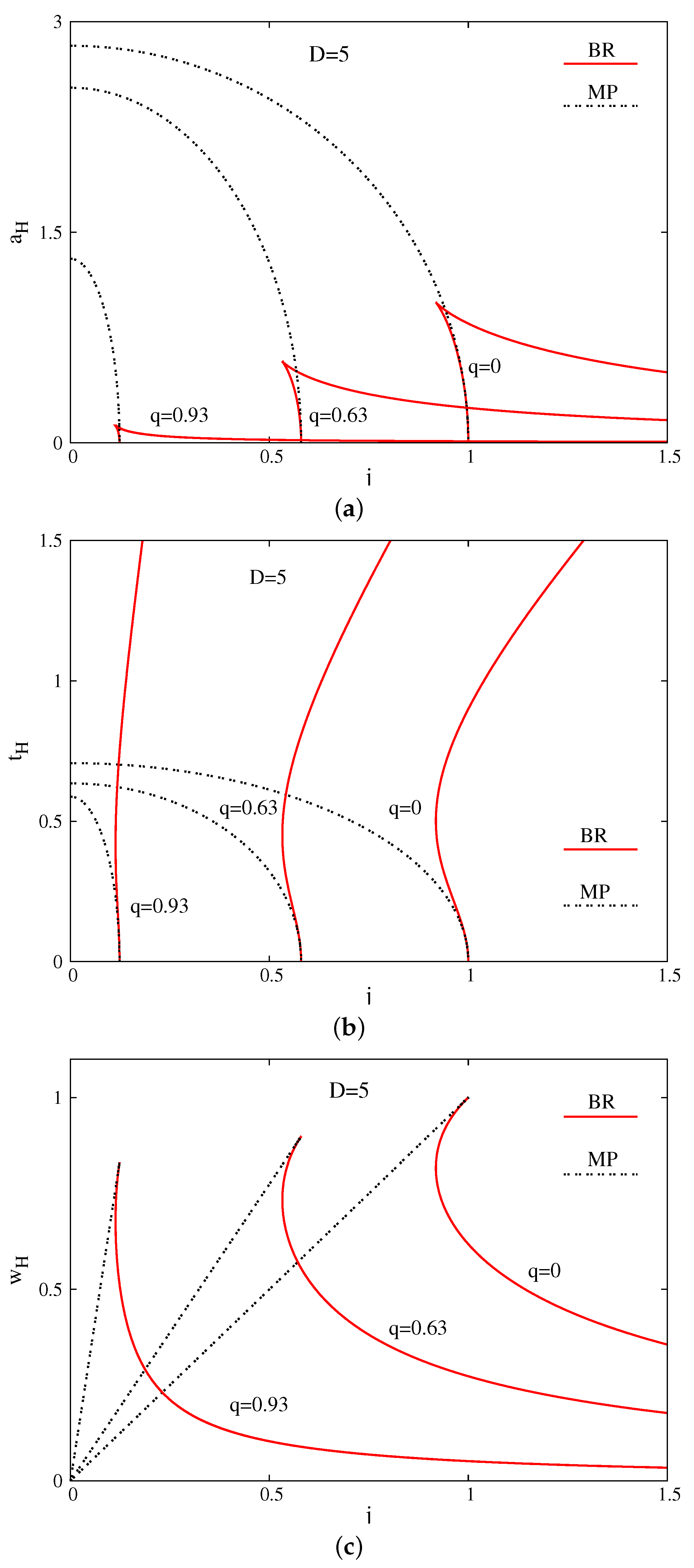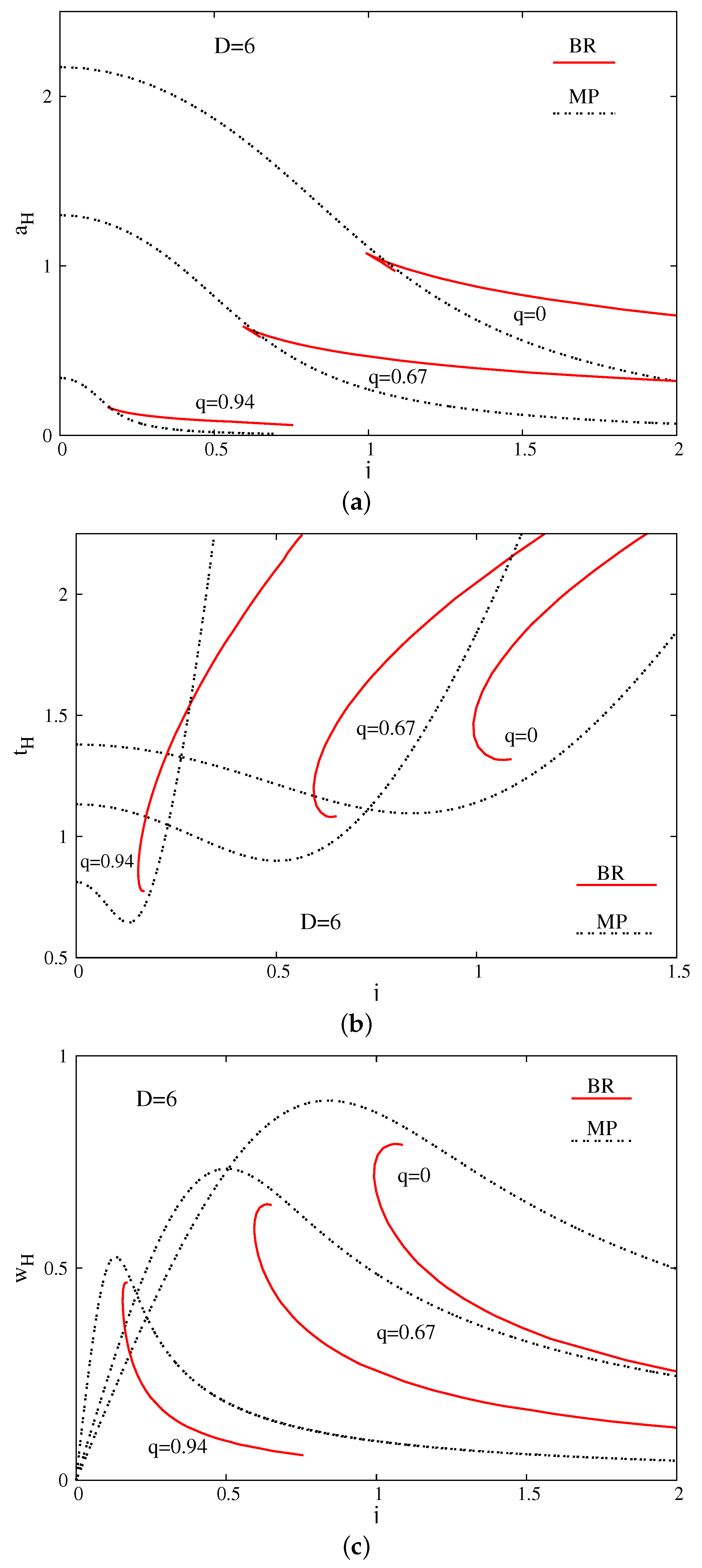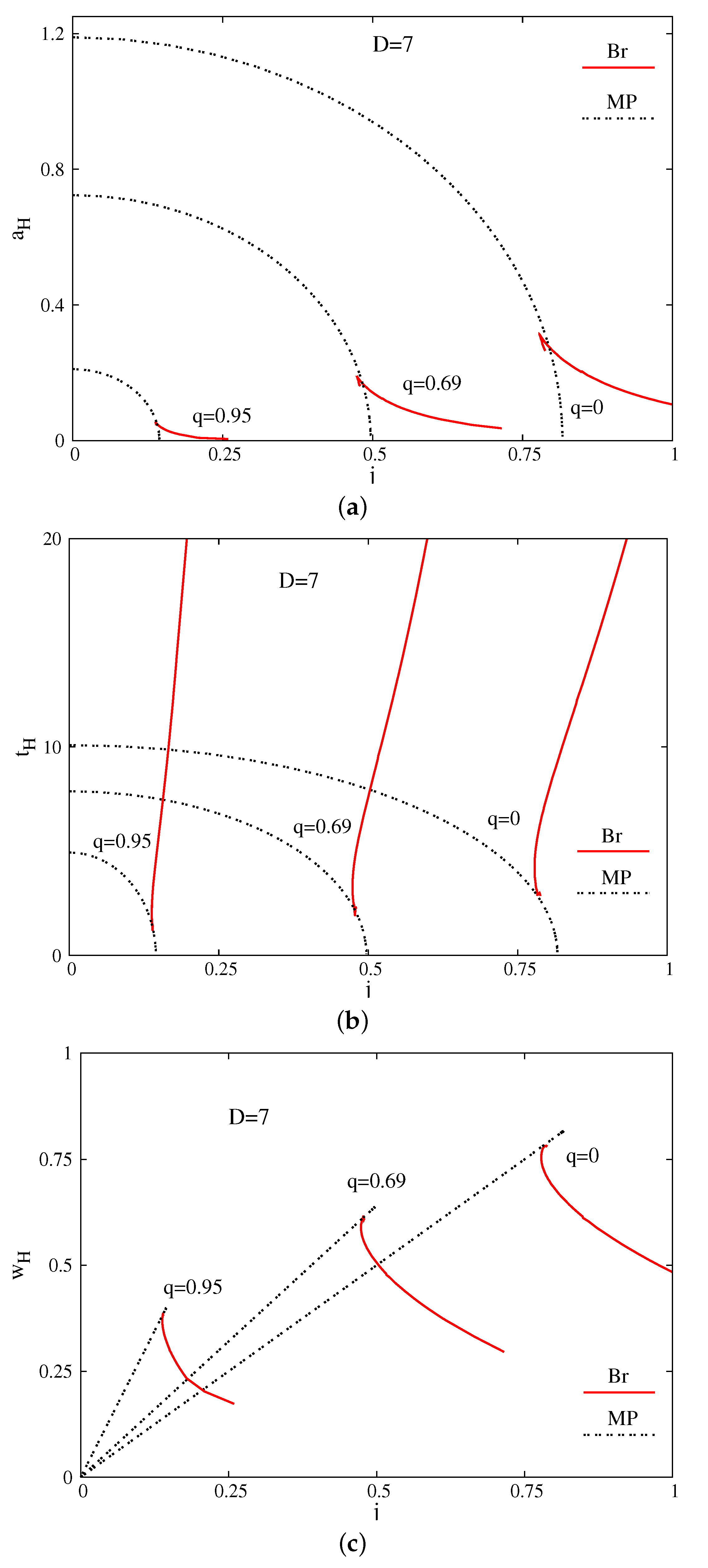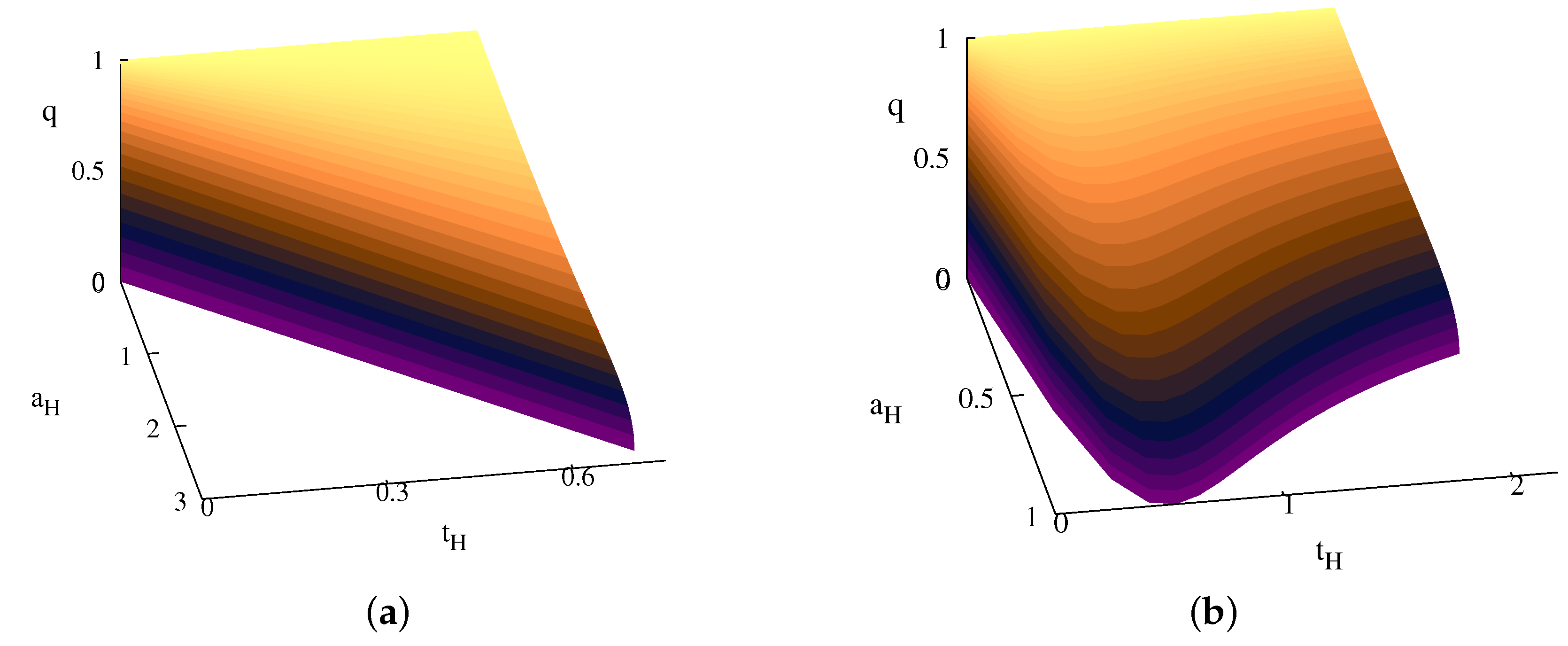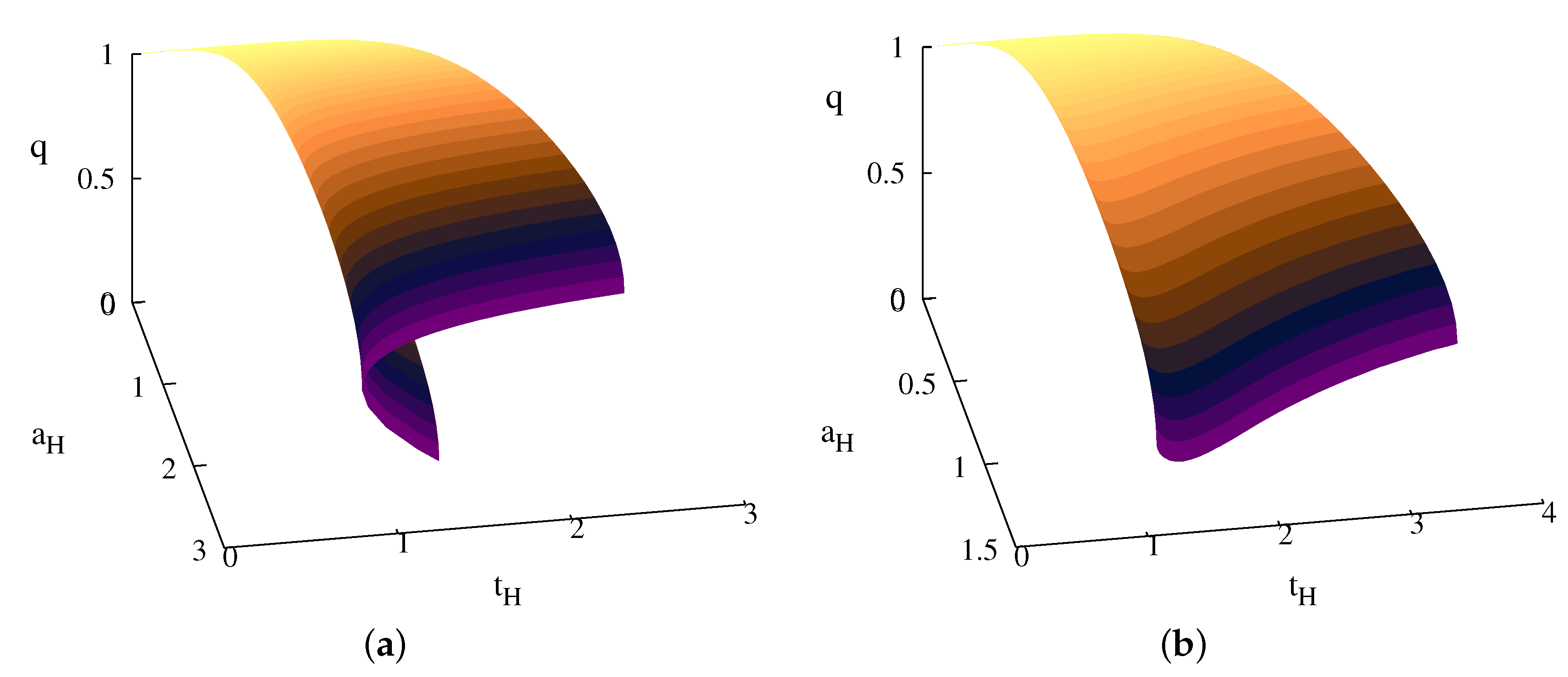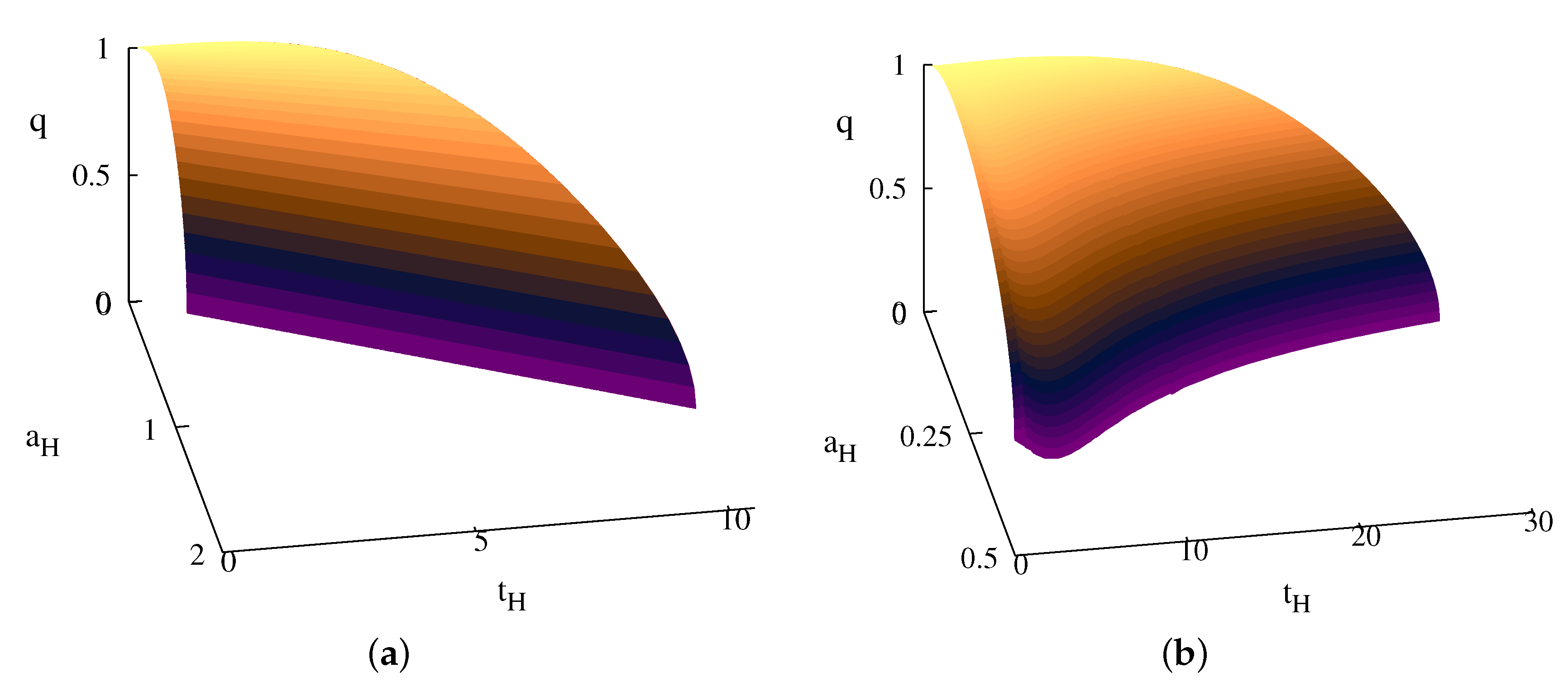1. Introduction
The study of black hole (BH) solutions in more than
dimensions is a subject of long standing interest in General Relativity. A seminal result in this area was the discovery of the
black ring (BR) by Emparan and Reall [
1,
2]. The
generalizations of the BR were constructed in [
3] within an approximation scheme, and fully non-perturbatively in [
4,
5] (although for
only). In contrast to the Myers–Perry (MP) BHs [
6], which have a spherical horizon topology being natural higher dimensional generalizations of the
Kerr solution [
7], the BRs have an event horizon of
topology, and possess no four-dimensional counterpart.
The rapid developments following the discovery in [
1,
2] have revealed the existence of a “zoo” of higher dimensional solutions with various topologies of the event horizon (a review of the existing results can be found in [
8,
9,
10]). In five dimensions a variety of BR solutions with (Abelian) gauge fields and scalars are known in closed form [
11]. (See also the Einstein–Maxwell numerical solutions in [
12].) However, most of the activity in this area concerns the pure Einstein gravity case without matter fields. In particular, to our knowledge, there is no non-perturbative construction of non-vacuum, singularity-free
black objects with a non-spherical horizon topology. (Note that the balanced Einstein–Maxwell BHs with
event horizon topology constructed in [
13] are not asymptotically flat.)
The main purpose of this work is to propose a general framework for the study of a class of asymptotically flat black objects in Einstein–Maxwell-dilaton (EMd) theory for a number
of spacetime dimensions. These black objects possess
equal magnitude angular momenta and can describe MP-like BHs with spherical horizon topology or balanced black objects with
horizon topology (with
and
). In the absence of matter fields, this framework reduces to that employed in [
14] to study BRs (
) and black ringoids (
). Here, we show that the approach in [
14] can be extended to the EMd case.
Moreover, for a special value of the dilaton coupling constant, all solutions in [
14] can be extended to the EMd case in a straightforward way by using a generation technique. This approach has the advantage to easily provide a window into the elusive general EMd case; also, we expect some of the solutions’ properties to be generic.
3. Solutions—The Kaluza–Klein Case
The only vacuum solutions which can be written within the Ansatz Equation (
5) and are known in closed form are the MP BHs and the
BR spinning in a single plane. Apart from that, the References [
4,
5,
12,
14] gave numerical evidence for the existence of BRs and black ringoids for several values of
.
Given the above formulation of the problem, EMd generalizations of these configurations can be constructed numerically, by employing the numerical scheme developed in [
14] for the vacuum case (see also [
15,
16]). Indeed, charged MP BHs were considered in [
17], while BR solutions have been studied in [
12], in both cases for
spacetime dimensions and a pure Einstein–Maxwell theory. By using a similar approach, we have found (preliminary) numerical evidence for the existence of
,
balanced black ringoids, again in the Einstein–Maxwell theory.
However, a numerical investigation of the generic EMd solutions is a complicated task beyond the purposes of this work. In what follows, we shall restrict ourselves to the special case of an EMd model with a Kaluza–Klein value of the dilaton coupling constant
a,
In this limit, the EMd solutions can be generated by using the (vacuum) Einstein black objects as seeds. (A similar approach has been used in [
18,
19] to study the MP BHs in EMd theory with a dilaton coupling constant given by Equation (24) and
BRs and black Saturns have been constructed in [
20,
21], in the same model.) The procedure is well known in the literature and works as follows: we first embed the
D-dimensional vacuum solutions into a
spacetime with a trivial extra coordinate
U,
Then, we perform a boost in the
t-
U plane with
,
. In the next step, we consider the following parametrization of the resulting in a
-dimensional boosted metric:
which allows for a straightforward reduction to
D-dimensions with respect to the Killing vector
. Then,
,
, and
Φ are identified with the
D-dimensional metric, the
D-dimensional Maxwell potential, and the dilaton function, respectively. In addition, they satisfy the EMd Equations (2)–(4) in
D spacetime dimensions.
Considering a vacuum Einstein gravity solution described by the metric Ansatz Equation (
5), a direct computation leads to the following expression of the EMd solution:
together with
where the superscript
stands for the pure Einstein gravity seed metric. One can easily see that these functions satisfy the boundary conditions (Equations (
11)–(
15)), since the seed solution is also subject to the same set of conditions.
For both the MP BHs and
BR seed solutions, it is straightforward to write down the corresponding closed form EMd generalizations. For example, in the MP case, one replaces in Equations (
27) and (
28) the following expression of the vacuum seed configuration [
14]:
being two input parameters and
where a different choice for
Δ is employed.
Having derived the expressions of the geometry and matter functions, it is straightforward to study all properties of the solutions. For example, in
Figure 1, we show the quantities
and
which encode the deformation of the horizon (see Equations (
16) and (
17)) for
black ring(oid)s and several values of the boosting parameter
α. One can see that the charged solutions share the pattern of the neutral ones, being shifted to smaller values of
j. For example, in the
case, the hole inside the ring shrinks to zero while the outer radius goes to infinity as a critical configuration is approached. (All results for MP BHs and
D = 5 BRs shown in the plots in this work are found by using the closed form expression of the vacuum seed solutions. For
D = 5 BRs, a comparison between the exact solution and the numerically generated one can be found in Appendix B of [
16].)
Moreover, for both closed form and numerical solutions, the quantities which enter the first law result from those of the corresponding vacuum seed configurations. A direct computation leads to
and
for the scaled variables.
One can see that the boosting parameter α is a monotonic function of the horizon electrostatic potential (or, equally, is uniquely fixed by the reduced charge q). In addition, given a mass , the electric charge cannot be arbitrarily large, with . The limit corresponds to singular black objects, with , and . Moreover, one can show that the Gibbs potential of the charged solutions equals that of the seed vacuum configurations , while .
It follows that, for any finite
α, some basic thermodynamic properties of these EMd solutions are qualitatively similar to the vacuum seed case. For example, as shown in
Figure 2,
Figure 3 and
Figure 4, the
and
diagrams of the charged solutions have the same shape for any value of
q. However, the curves in the phase diagram get shifted to lower
and
j as the charge parameter
q is increased.
In addition, a generic property of the solutions is the occurrence of a cusp in the
black ring(oid) diagram, where a branch of “fat” black ring(oid) solutions emerges, with the existence of a minimally spinning solution. A comparison of the results (with the set of MP-like solutions included), suggests that, similar to the vacuum case, the
black ringoids with
horizon topology are the natural counterparts of the
BRs. As noticed in [
21], the branch of “fat”
charged BRs ends in a limiting singular solution with
and nonzero
j. The same configuration is also approached by the charged MP BHs with maximal
j. The existing data strongly suggest that this is the picture also for the
charged Br and MP solutions. (It is interesting to note that, similar to the vacuum case, the reduced angular momentum
j is bounded from above for charged MP BHs with
equal magnitude angular momenta in
only.)
However, a different pattern is found for
solutions. There, the charged “fat” BRs exhibit a different limiting behavior; similar to the vacuum case, they end in a critical merger configuration [
3], where a branch of “pinched” BHs is approached in a horizon topology changing transition. The “pinched” BHs possess a spherical horizon topology and can also be studied within the framework in
Section 2. Such solutions have been constructed in [
5] (in the vacuum case), branching off from a critical MP solution along the stationary zero-mode perturbation of the Gregory–Laflamme-like instability [
22,
23]. The results in [
5] together with Equations (
27) and (
28) show that the critical merger EMd solution has a finite, nonzero area, while the temperature stays also finite and nonzero.
The (area-temperature-charge) diagram of the MP, BRs and black ringoids is shown in
Figure 5,
Figure 6 and
Figure 7 (in principle, the equation of state
can be deduced from there). One can notice that the five-dimensional case is special, since, as
,
for
, while
for
.
Finally, let us mention that, for any event horizon topology, the gyromagnetic ratio (Equation (
23)) has a remarkable simple expression in terms of
α only,
and varies between
(for maximally charged solutions
,
) and
(for solutions with an infinitesimally small charge
,
,
). Note that this is consistent with the general results obtained in [
24].
4. Conclusions
Fifteen years after the discovery of the BR by Emparan and Reall [
1,
2], the study of BHs with a non-spherical horizon topology continues to be a source of excitement in higher dimensional General Relativity. However, most of the black objects with a nonspherical horizon topology studied in the literature describe vacuum configurations only. (Higher-dimensional rotating BHs in Einstein gravity coupled to a 2-form or 3-form field strength and to a dilaton with arbitrary coupling have been studied in [
19]. These solutions are constructed within the blackfold approach and describe charged MP BHs and various black objects with a non-spherical horizon topology.) Moreover, it is worth noticing that, even for the case of an event horizon with spherical topology, very few solutions with matter fields are known in closed form. (For example, the higher dimensional generalization of the Kerr–Newman solution is only known numerically [
17,
25,
26,
27].)
The main purpose of this work was to generalize the non-perturbative framework used in [
14] for the study of several classes of vacuum black objects with
equal angular momenta, to the case of Einstein–Maxwell-dilaton theory. Our results show that, similar to the pure Einstein gravity case, for the general dilaton coupling constant, the problem reduces to solving a set of coupled PDEs with suitable boundary conditions on a rectangular domain, employing an adequate numerical scheme [
14].
As a preliminary step before considering the generic case, we have studied solutions of EMd theory with the Kaluza–Klein value of the dilaton coupling constant. In this special limit, the action in D dimensions is obtained by reducing the dimensional vacuum Einstein action, while the solutions are found by embedding the D dimensional vacuum solutions in dimensions and boosting in the extra direction.
The resulting EMd solutions are asymptotically flat, and either possess a regular horizon of spherical topology (and thus represent charged generalizations of MP BHs), or an topology (and thus represent charged BRs and black ringoids). These black objects are characterized by their global charges: their mass, their equal magnitude angular momenta, and their electric charge.
As mentioned above, these results were obtained only for a particular value of the dilaton coupling constant. Note that an extension of the generating technique in
Section 3 can be used to construct (toroidally compactified) heterotic string theory generalizations of the vacuum black objects within the Ansatz Equation (
5). In that case, an approach to obtain the charged solutions from the neutral ones was presented in [
28]. Again, the properties of the new configurations can be derived from the corresponding vacuum solutions. It remains a challenge to generalize EMd solutions to arbitrary values of the dilaton coupling constant, including the pure Einstein–Maxwell case. The construction of more general configurations (
, higher dimensional generalizations of the
dipole BRs [
29], solutions with a Chern–Simons term or black objects coupled with a
p-form field (with
)) is another important open question, just like the inclusion of a cosmological constant. We hope to return elsewhere with a systematic study of these aspects.
